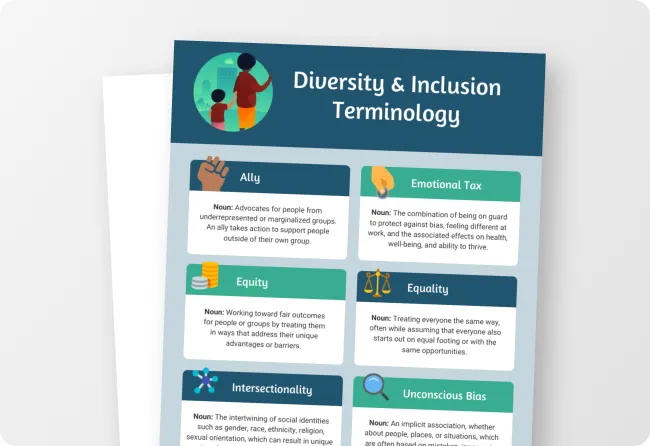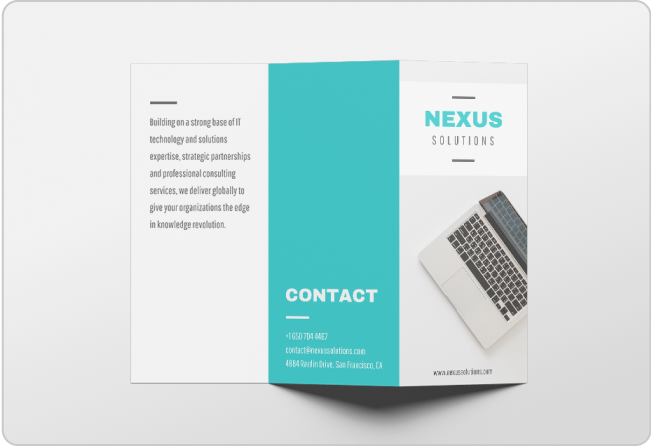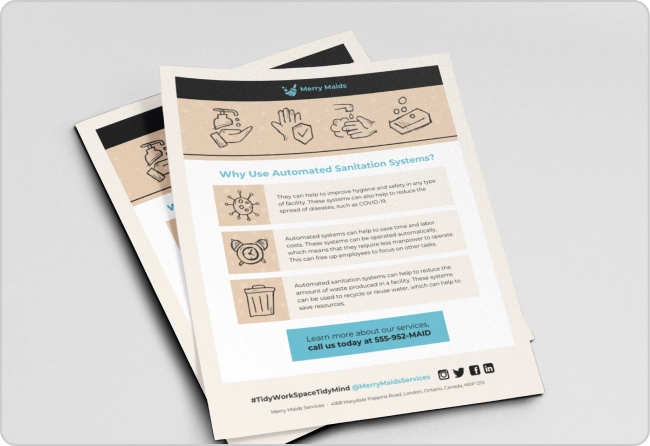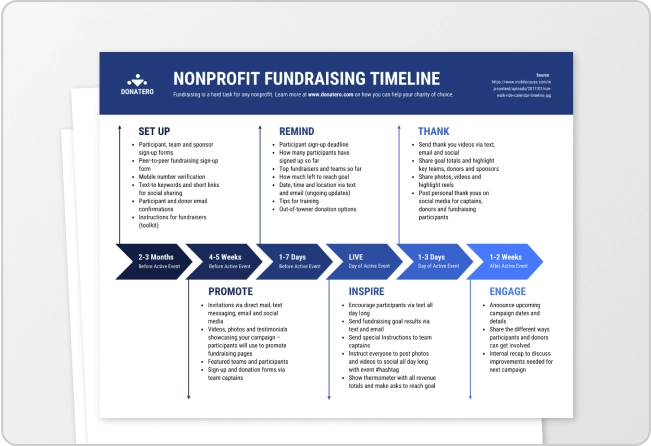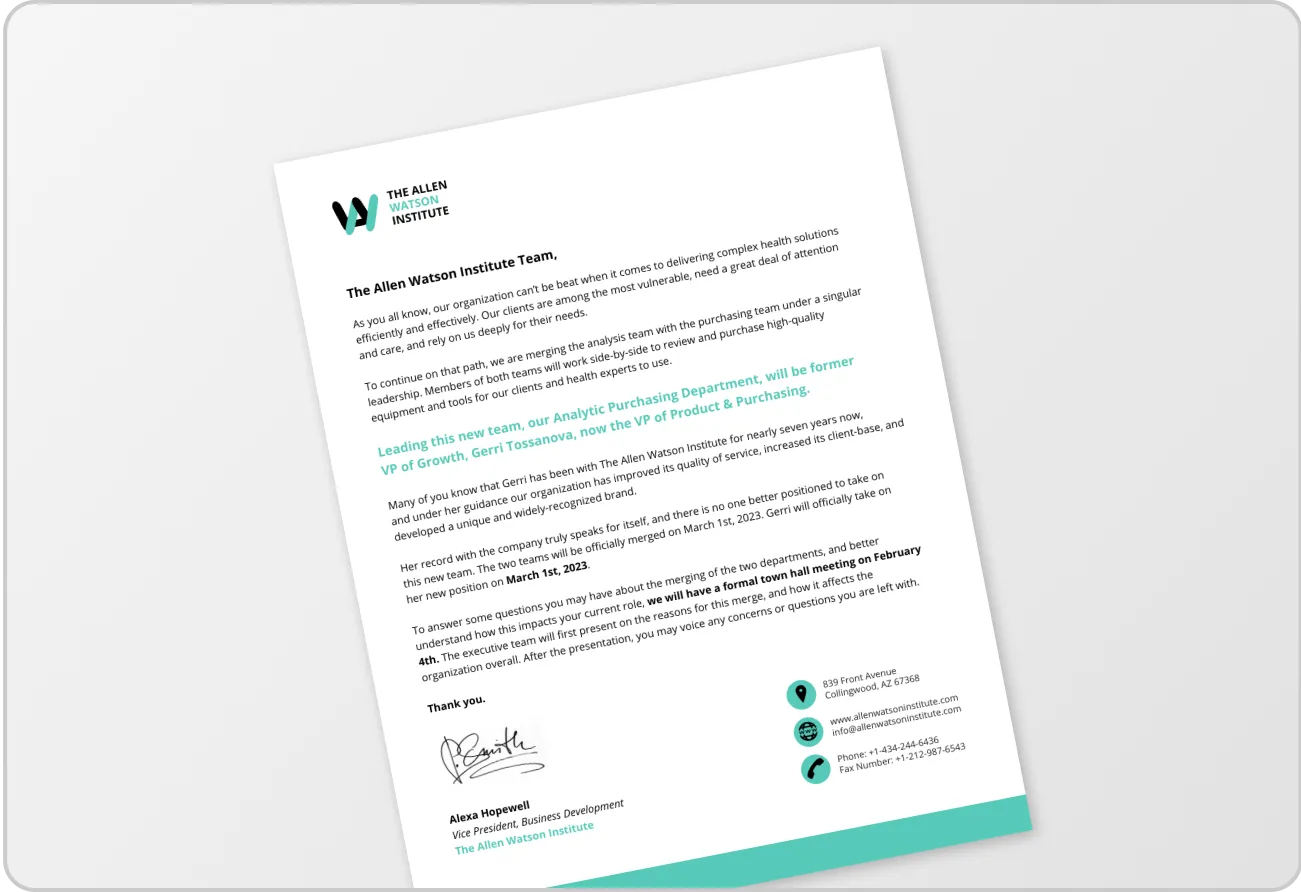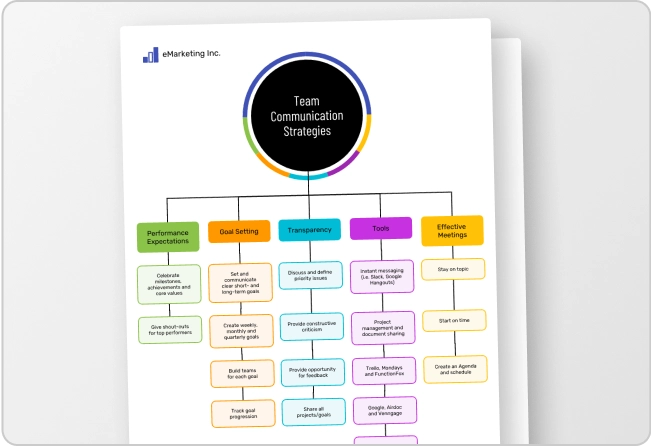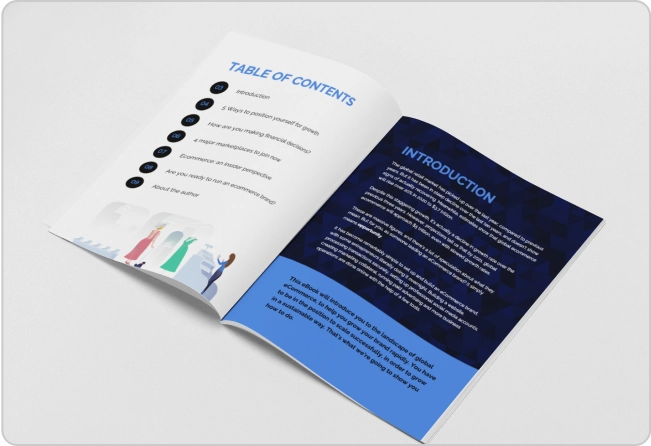
Wondering if selling ebooks online is actually profitable? The short answer—yes, if you approach it strategically. With the right niche, platform, pricing, and marketing, you can make money by selling ebooks online, whether you’re a seasoned writer or just starting out.
In this guide, I’ll walk you through what you need to launch your first ebook, how to choose a niche that sells, and where to publish it for the best return. From crafting compelling content to setting smart prices and promoting it effectively, you’ll get a clear roadmap for turning your ebook into a revenue stream.
Want a head start on designing an ebook? Check out our collection of eye-catching ebook templates and start customizing your own today.
What is an ebook and why sell it?
An ebook is a digital book you can read on phones, tablets, computers or e-readers. Common formats include PDFs for guides and workbooks, EPUB for Kindle and interactive files with videos or clickable elements.
Selling ebooks is a smart move—they’re affordable to create, easy to scale and can bring in passive income. You write it once, and it keeps working for you.
As more people turn to digital content for learning and entertainment, ebooks offer a flexible, low-barrier way to share your expertise and earn online.
12 Tips to write an ebook that actually sells
For writers just starting out on their literary journey or with a budget, publishing ebooks are often more budget-friendly. However, selling an ebook without an established audience might feel like stepping into uncharted territory.
Before you start discarding the idea of selling ebooks online, I’ve got you covered with these 12 tips to help you take your first step into the ebook market:
1. Choose the right niche
Selecting a niche that resonates with your target audience is a critical step in ebook creation. Research popular and trending topics within your expertise. Analyze audience interests, competition and potential demand.
2. Create high-quality content
Your ebook content should be valuable, accurate and engaging. Thoroughly research your topic, provide actionable insights and present information in a clear and organized manner. Address your readers’ pain points and provide solutions that truly benefit them. The more value you offer, the more likely readers are to recommend and buy your ebooks.
3. Design a professional cover
Don’t judge a book by its cover? We all do! Your ebook cover design is a visual representation of your content’s quality. Hire a professional designer or use design tools to create an eye-catching cover that conveys the essence of your ebook. Colors, imagery and typography should align with your content’s tone and genre to attract potential buyers.
Your ebook cover aside, check out these inspiring ebook examples to get an idea of how you can enhance readability with a good design.
4. Leverage ebook publishing platforms
Utilize ebook publishing platforms such as Amazon’s Kindle Direct Publishing, Smashwords or others that align with your goals. These platforms provide access to a massive online audience and streamline the distribution process. Follow their guidelines for formatting and metadata to ensure your ebook is well-presented to potential buyers.
5. Optimize pricing
Research similar ebooks in your niche to determine competitive pricing. Consider factors like length, value and your target audience’s willingness to pay.
6. Implement effective marketing strategies
Consistent and strategic promotion can significantly increase your ebook’s visibility. Some effective ebook marketing strategies include creating a professional website or landing page for your ebook and promoting it through social media, email marketing, guest blogging and collaborations with influencers. To quickly enhance your ebook’s visibility, consider using social media platforms such as Instagram to reach a wider audience. Utilizing strategies that allow you to get Instagram followers can effectively jumpstart your marketing campaign.

7. Collect and use reviews
Positive reviews build credibility and trust. Encourage readers to leave reviews on platforms like Amazon, Goodreads or your own website. Display these reviews prominently to showcase your ebook’s value and encourage new readers to make a purchase.
8. Offer value-added content
Enhance your ebook by including supplementary materials that complement the main content. These could be worksheets, templates, case studies or additional resources. Value-added content elevates the reader’s experience and justifies a higher price point.
9. Engage with readers
Establish a connection with your audience by responding to comments on social media, blog posts and emails. Create a sense of community around your ebook, making readers feel heard and valued.

10. Diversify revenue streams
Explore opportunities to expand beyond direct ebook sales. Consider creating related products, such as audiobooks, online courses or exclusive memberships. This diversification not only increases your revenue but also caters to varying audience preferences.
11. Monitor sales and adapt
Regularly analyze your ebook’s sales data and performance metrics. Identify trends, understand what’s working and make necessary adjustments. Tweak and adapt as needed and your ebook will thrive in this ever-changing digital world.
Study authors who have achieved success in ebook sales. Analyze their marketing strategies, engagement techniques and writing styles. Get inspired by their strategies, but remember, you’re the unique ingredient that makes your ebook sizzle.
Lastly, embrace consistency and patience. Remember, every reader you connect with is a step toward building a loyal audience that appreciates your content.
That said, while quality content is crucial, aligning your content with the right audience and utilizing platforms that enhance visibility, credibility and user experience. Moving on, let’s talk about what are some of the platforms that can position your ebook for optimal reach and impact in the digital realm.

6 steps to sell an ebook on your website
Platforms aside, are you also considering selling your ebooks on your website? If the answer is yes — you’re in for a savvy online business move.
Self publishing ebooks on your website allows you to bypass third-party platforms that often take a significant cut of your earnings. You retain a higher percentage of each sale, translating to more revenue in your pocket. Here’s your playbook on how to sell an ebook directly from your website:
1. Create your ebook
Pour your expertise, creativity and knowledge into crafting an ebook that stands out. Write engaging content that resonates with your audience and format it to ensure readability and visual appeal. Remember, offering it in common digital formats like PDF, EPUB or MOBI ensures it’s accessible to a wide range of readers.
2. Choose an ecommerce solution
Choose an ecommerce platform that seamlessly integrates with your website. Consider options like WebCommander, WooCommerce (ideal for WordPress users), E-junkie or Gumroad that’ll provide the tools you need to manage transactions and digital deliveries effortlessly.
Ensure you choose a robust ecommerce hosting provider that focuses on security to keep customer data safe.
3. Set up your online store
Get your virtual store ready for business. Self-published authors and dropshipping entrepreneurs alike can follow the platform’s setup instructions to configure the store to their liking.
Choose the right currency, establish shipping options and determine tax settings based on your location and legal requirements. This setup lays the foundation for a smooth customer experience. You can also convert your website into a mobile app and use another way to increase e-book sales.
4. Add your ebook product
It’s time to introduce your ebook to the world. Write a captivating title and description that entices potential buyers. Include an eye-catching cover image that gives a sneak peek into your ebook’s essence. Lastly, set a price that reflects your ebook’s worth and the value it brings to readers.
5. Enable secure digital delivery
Ensuring the secure delivery of your ebook is paramount. Configure your chosen ecommerce platform to trigger automatic digital delivery upon successful payment. Protect your content with digital downloads that generate secure links that expire after a specific time and use high-quality VPN auto-connect. This step safeguards your ebook and enhances the customer experience.
It’s all about the pitch. Craft a sales page that’s irresistible – sizzling copy, visuals that pop, and benefits that make them nod in agreement. Add those ‘Buy Now’ or ‘Add to Cart’ buttons like VIP invitations to a party they won’t want to miss.
Additionally, building a self-sustaining platform sets the stage for long-term success. As your audience grows, your website becomes a hub for all your content, helping you establish yourself as a trusted authority in your field.

7 Best platforms to sell your ebooks online
If you’re an ebook publisher, you’ll know that selling your ebook on the right platforms is more than a mere choice—it’s a strategic move that can significantly impact your reach, sales and overall success. Beyond marketplaces and creator tools, publishers with established traffic may prefer enterprise ecommerce platforms so they can sell ebooks directly, maintain brand consistency, and leverage advanced merchandising and analytics.
When it comes to bringing your ebooks to the digital marketplace, these platforms offer a variety of avenues for success:
1. Amazon Kindle Direct Publishing (KDP)

Amazon’s KDP is a powerhouse, granting access to an immense readership through its ebook store. Leverage its user-friendly interface to publish, promote and profit from your ebooks within a global marketplace.
Amazon’s Kindle Direct Publishing allows free publishing and charges a royalty based on your ebook’s price. If you select the 35% royalty option, your royalty will be 35% of your list price without VAT for each unit sold.
Alternatively, if you choose the 70% royalty plan, your earnings will be 70% of your product’s price, excluding VAT. However, this will be reduced by delivery costs (usually around $0.06 per unit), which vary depending on the size of the file. This applies to each eligible book sold to customers in the 70% territories. For customers outside these territories, your earnings will be 35% of the price, excluding VAT.
2. Smashwords

Smashwords shines as a distribution champion. With a single upload, your ebook can be made available on significant platforms like Apple iBooks, Barnes & Noble and more. Its far-reaching distribution network maximizes your ebook’s visibility.
Smashbox distributes to major retailers, and you’ll receive 60% of the list price you set. For library sales, authors receive 45% of the price (libraries buy one copy, lend it multiple times, one at a time). Royalty percentages might vary depending on the country, retailer or VAT taxes.
3. Draft2Digital

Embrace ease with Draft2Digital. This platform streamlines your ebook’s distribution across major online stores, including Amazon, Apple, Kobo and others. Its intuitive tools help you sidestep technical roadblocks, allowing you to concentrate on your writing.
Draft2Digital doesn’t charge upfront fees for any of its services but instead charges around 10% of the price you establish for your book’s list price. That means most of the stores take about 30%, Draft2Digital takes about 10%, and you get to keep about 60% of the list price of your ebook.
4. Payhip
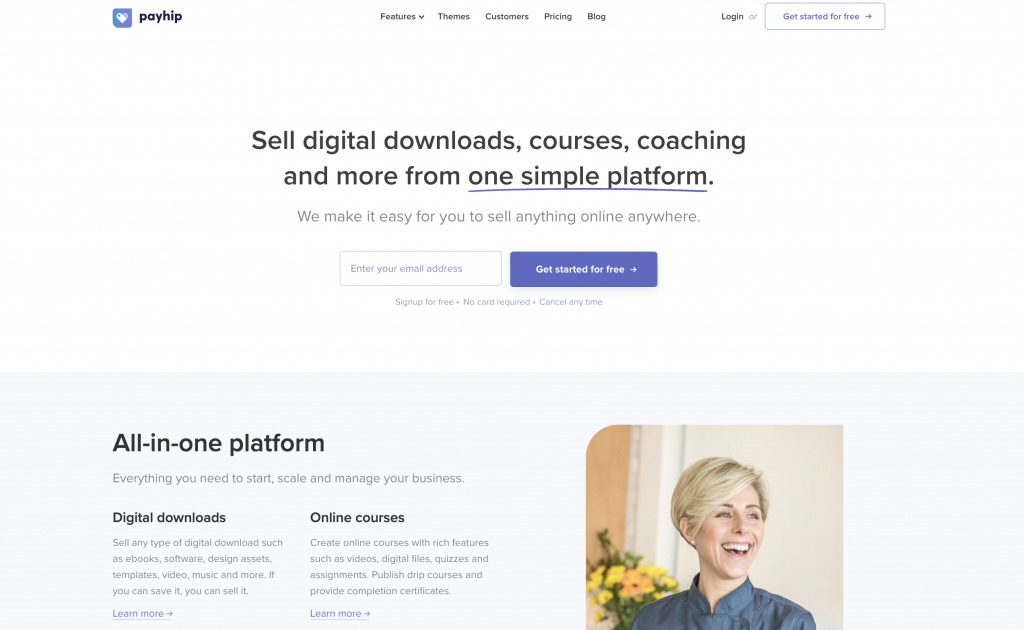
Customization and convenience go hand in hand with Payhip. Not only can you sell ebooks directly to your audience, but you can also tailor pricing and seamlessly integrate the platform into your website to sell digital products.
Payhip charges a transaction fee per sale, starting at 5% per transaction. There’s also an option for a monthly subscription fee for higher-tier plans that require no transaction fee at all.
5. Gumroad

Gumroad goes beyond ebooks, catering to creators of various digital products. Alongside ebooks, you can sell memberships, music and art. This versatile platform opens doors to diversified income streams.
The platform charges a 10% fee per ebook online sale, excluding credit card processing and PayPal fees. There are no hidden charges, monthly payments or additional fees.
6. Lulu

Lulu stands as a comprehensive partner for authors. Beyond ebook distribution, it offers an array of publishing services. With Lulu, you’re not only releasing your ebook but also tapping into a supportive ecosystem.
Your ebook revenue may vary depending on the retail sites you choose for distribution. That’s because some places (like Lulu, Apple, and Barnes & Noble) act like sales agents – they sell your ebook at the price you set and then take a cut from that.
Other places like Amazon or Kobo on the other hand are resellers. They buy your ebook at a fixed price from a middleman and can sell it at any price, even with discounts. With the reseller bunch, you’ll always earn what you see in the retail pricing step, no matter what they end up charging for your book.
7. BookBaby

Elevate your author journey with BookBaby’s comprehensive approach. Beyond distribution, this platform equips you with marketing tools and essential author services. It’s an encompassing solution for authors ready to make their mark.
BookBaby’s pricing depends on the services you require, such as ebook distribution, formatting, editing and cover design. Costs vary based on your package selection.
For eBooks priced from $2.99 to $9.99, the earnings structure is as follows:
- 70% for sales in Austria, Australia, Belgium, Canada, France, Germany, Liechtenstein, Luxembourg, Monaco, Switzerland, United Kingdom (including Guernsey, Jersey, and Isle of Man) and the United States (after deducting an Amazon delivery fee based on book size).
- 35% for sales in all other countries.
For eBooks priced below $2.99 and above $9.99, the earnings rate is a flat 35% of sales.
Each platform presents unique features, making it vital to align with the one that suits your vision and objectives. With these platforms at your disposal, your ebook’s potential for success knows no bounds.
Is selling ebooks still profitable in 2025?
Yes—selling ebooks online is still a profitable digital income stream in 2025.
- Market trends
According to statistics, the global ebook market is projected to reach $14.9 billion in revenue this year, with over 1 billion users accessing ebooks across devices. Demand for digital content continues to grow as more readers shift to tablets, smartphones, and e-readers. - Real creator earnings
Income varies, but success is possible. One self-published author reported earning $45,000 across several ebooks by refining her content and optimizing sales over time. Another creator made $5,600 from just two ebooks in 14 months using Gumroad. - Top-Selling Niches
Evergreen topics like health, personal finance and productivity continue to dominate. Readers consistently seek practical, problem-solving content, making these niches a strong starting point for creators.
5 Ebook genres that sell well online
Within the digital realm of ebooks, certain genres have undeniably captured the attention and preference of readers. Here are five genres that consistently demonstrate robust sales figures:
1. Romance
Love is always in the air in the ebook world — the romance genre remains an enduring favorite among readers. Whether it’s swooning over contemporary romance, getting lost in historical tales or diving into the mysterious world of paranormal romance, readers can’t get enough of heart-fluttering stories.
2. Mystery/thriller
Who doesn’t love a good suspense-filled page-turner? Mystery, thriller and crime fiction have readers on the edge of their digital seats, craving those spine-tingling twists and turns.
3. Business and money-making guides
The digital age has ushered in a surge of interest in entrepreneurship, finance and self-improvement. Ebooks that provide valuable insights into business strategies, financial acumen, bookkeeping side hustle, and pathways to personal growth are highly sought after by readers aiming to enhance their professional and financial trajectories. Aspiring bookkeepers can use these resources to find bookkeeping clients and build a thriving business.
4. Self-help and personal development
The quest for self-improvement remains a pervasive theme, prompting a consistent demand for self-help and personal development ebooks. These titles offer readers practical advice and actionable steps to enhance various facets of their lives, from health and wellness to productivity and overall well-being.
5. Health, fitness & dieting
The wellness wave is in full swing. Readers are diving into health, fitness and dieting ebooks to uncover the secrets of a balanced and healthy life.
Each of these genres taps into the unique advantages of ebooks, catering to readers’ preferences for convenience, variety and instant access. By exploring these popular genres and infusing your unique voice and perspective, you can position yourself for success in the dynamic world of digital publishing.

Legal and Tax Considerations
Publishing and selling an ebook comes with important legal and tax responsibilities. Addressing these early helps establish your credibility, protects your work and ensures compliance with international regulations.
While this isn’t legal or tax advice, understanding the basics, especially if you’re monetizing your content, this shows professionalism and builds trust with your audience.
Consider consulting a qualified expert for personalized guidance. Here are the key points to cover:
- ISBN & copyright
- An ISBN (International Standard Book Number) helps track and distribute your ebook through bookstores and libraries. Some platforms require it, while others (like Amazon KDP) may assign one for you.
- Copyright registration offers formal proof of ownership and makes it easier to defend your content in case of infringement.
- Digital tax rules
- Digital products are subject to VAT or GST in many countries, particularly in the EU, UK, Australia and Canada.
- Amazon KDP automatically collects and remits VAT for qualifying sales, reducing the admin on your end.
- Gumroad also manages VAT/GST obligations based on the buyer’s location, making compliance easier for creators.
- Disclaimers & refund policy
- If your ebook contains advice, especially in areas like health, finance or law include a clear disclaimer to limit liability and set expectations.
- Add a visible refund policy to protect your business and help reduce disputes. A transparent policy builds buyer trust and aligns with consumer protection standards.
Taking these steps shows you’re running a legitimate, professional ebook business, earning both your readers’ trust and your platform’s confidence.
FAQs on selling ebooks online
Do I need an ISBN?
An ISBN isn’t required to sell ebooks on most platforms like Amazon KDP or Gumroad, but it may be needed if you plan to distribute through libraries or certain retailers.
What formats should my ebook be in?
Your ebook should ideally be available in formats such as PDF, EPUB and MOBI. These ebook formats ensure compatibility with a wide range of devices, from computers to e-readers and smartphones, making it easier for readers to access your content seamlessly.
Do I need to have a published physical book to sell an ebook?
No, having a physical book isn’t a requirement for selling ebooks. Ebooks are digital products that can be distributed and sold online without the need for printing or physical distribution.
What you need to start selling ebooks online
To start selling ebooks online, you’ll need:
1. Writing & design tools
- Writing: Google Docs, Microsoft Word, or Scrivener
- Design: Venngage, Canva or Adobe InDesign for layout and cover
2. Ebook formatting tools
- Use Calibre or Kindle Create to convert files into:
- PDF – Great for fixed layouts like guides and workbooks
- EPUB – Standard format for most e-readers and Kindle
- MOBI – Older Kindle format, now mostly replaced by EPUB
3. Legal basics
- Copyright: Automatically granted when you create your ebook; optional to register formally
- ISBN: Not always required for digital sales, but necessary for broader distribution (explained later)
With these basics covered, you’re ready to publish and sell your ebook online.
How do I price my ebook?
Most ebooks are priced between $2.99 and $19.99. Your ideal price depends on:
- Niche: High-value topics like business, health, and finance support higher pricing.
- Length: Longer, in-depth ebooks can justify a higher cost.
- Perceived Value: Strong design, exclusive insights, and practical takeaways increase value.
Tips to refine your pricing strategy:
- A/B test different price points to see what converts best.
- Use limited-time offers to drive urgency.
- Bundle your ebook with extras like templates or worksheets to boost perceived value.
Start with a competitive price, then adjust based on performance and reader feedback.
What type of ebook sells the most?
Genres like romance, mystery/thriller, business guides, self-help and health/fitness are popular choices for readers. These genres tend to have broad appeal and engage a wide range of audiences.
How do you deliver an ebook after purchase?
Most platforms like Gumroad, Shopify or Amazon KDP automatically deliver your ebook file (PDF, EPUB, etc.) to the buyer after payment.
Do I need to have technical skills to sell ebooks?
While some technical familiarity can be advantageous when you sell ebooks online, it’s not a strict requirement. Many user-friendly ebook platforms provide straightforward tools for uploading, formatting and selling your ebook without extensive technical expertise.
Can you make money selling ebooks on Amazon?
Yes, you can self-publish and sell ebooks on Amazon for free using Kindle Direct Publishing (KDP); Amazon takes a percentage of each sale.
How do I receive payments for eBook sales?
Most ecommerce platforms offer multiple payment options, including PayPal, direct deposit or checks. These platforms handle payment processing, ensuring you receive your earnings conveniently.
How do I track the sales of my eBook?
Ecommerce platforms typically provide a dashboard or analytics section where you can track your ebook sales, monitor performance metrics, and gain insights into your audience’s preferences.
How to sell ebooks without writing them?
If you’re not a writer — you can always hire a ghostwriter to create the content for you. Alternatively, you can purchase Private Label Rights (PLR) content, which allows you to modify and sell pre-existing material.
How to sell ebooks for free?
Platforms like Amazon KDP allow you to self-publish ebooks at no upfront cost. You earn royalties from each sale and there’s no initial investment required.
How to promote and sell your ebook?
Selling your ebook starts with smart promotion. Here’s how to build visibility and drive sales:
1. Use Lead Magnets & Email Funnels
Offer a free preview or checklist as a lead magnet to collect emails. Then set up an email funnel using tools like ConvertKit or Mailchimp to nurture subscribers and pitch your ebook.
2. Promote on Social Media
Share value-packed content and teaser quotes on Instagram Reels, TikTok, or LinkedIn. Collaborate with influencers in your niche to expand your reach.
3. Repurpose Your Ebook
Turn chapters into blog posts, short videos, or carousels. This multiplies your content and brings in organic traffic.
Tools to help:
- Email marketing: ConvertKit, Mailchimp
- Social media & video: Canva, Instagram Reels, TikTok
- Influencer outreach: Collabs via Instagram or niche communities
The more platforms you show up on, the better your chances of getting noticed and making consistent sales.
Are ebooks profitable?
Yes, ebooks can be profitable, but success depends on factors such as quality of content, effective marketing, target audience, and pricing strategy. With lower production and distribution costs compared to traditional print books, ebooks have the potential to generate decent profits if properly executed.
Can you sell PLR ebooks without writing them?
Yes, with PLR (Private Label Rights) ebooks, you can sell pre-written content as your own. They’re fast to launch, but often lack originality unless you customize the content, title and design. Always check the license to ensure you’re allowed to edit, brand and resell legally.
How to create an ebook with Venngage
In the world of words and screens, the question on everyone’s mind is: Can ebooks truly be a money-making venture? The answer? Absolutely! Ebooks have shown time and again that they’re not just pages on a screen; they’re potential goldmines for authors, publishers and aspiring writers.
So, you’ve got something awesome to share and you’re ready to turn it into an ebook that catches everyone’s eye? Well, good news – Venngage has got your back!
Venngage’s intuitive interface and user-friendly drag and drop editor enables you to craft professional-grade ebooks even if you’re not a design expert. Besides, with Venngage. not only you can build an ebook but also add interactive elements like links, buttons and embedded videos to create an interactive ebook.
Here’s the scoop on how to make your own killer ebook:
1. Sign up or log in: The first step is to create your account on Venngage if you don’t have one already. After signing up, log in to get started with crafting your ebook.
2. Pick a template: Browse through the diverse collection of ebook templates offered by Venngage. Choose a template that aligns with your ebook’s theme and style.
3. Personalize your template: Make the template your own by adding your unique touch. Rearrange elements, insert your brand’s colors and tweak the design to match your vision.
4. Add and adjust elements: Enhance your ebook’s visual appeal by incorporating various elements like text, images, icons and charts. Rearrange and resize these elements to achieve the desired layout.
5. Insert your content: Seamlessly integrate your ebook’s content into the template. Write or copy-paste your text, ensuring readability through well-structured headings and proper formatting.
6. Download and share: When you’re satisfied with your customized ebook, it’s time to share it with the world. Upgrade to a Premium or Business plan to download your preferred ebook format, such as PDF, and spread the word across different platforms.
Don’t worry if you’re no design expert. With Venngage, you don’t need to be a design whiz to make a show-stopping ebook. So, grab those ideas, mix in a bit of creativity and get ready to rock your very own ebook like a pro!






























